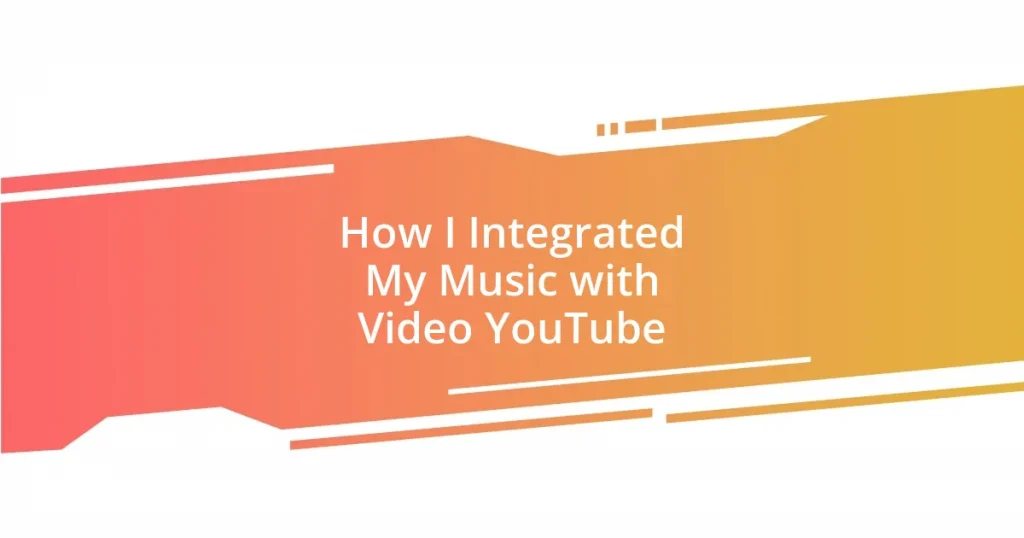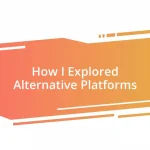Key takeaways:
- Music videos enhance storytelling and emotional connection, transforming songs into multi-layered experiences.
- Choosing visuals that align with a song’s themes can significantly impact audience engagement and emotional resonance.
- Synchronization between music and visuals is crucial; timing and contrasting rhythms can evoke deep emotional responses.
- Active audience engagement and feedback are essential for refining content and building a community around your music.
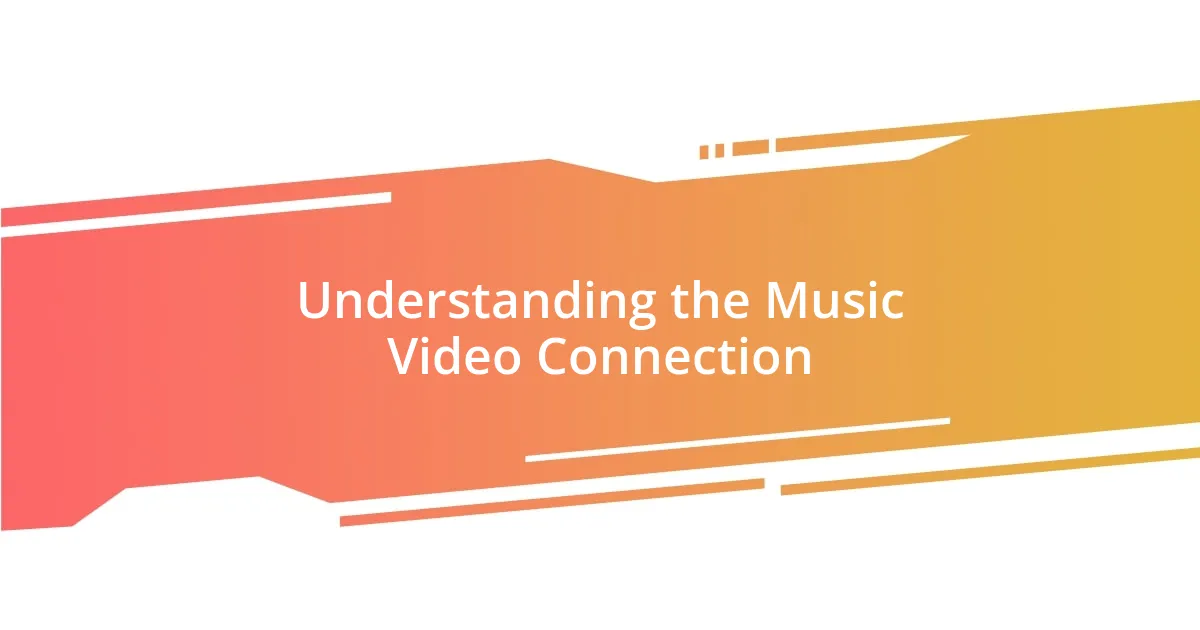
Understanding the Music Video Connection
When I first started integrating my music with video, it struck me how deep the connection really runs. Music videos are not just a means of showcasing songs; they’re a powerful storytelling medium that amplifies emotions and meanings. Have you ever found yourself more moved by a song after watching its video? I know I have.
I remember the thrill of creating my first music video, where every visual element was an extension of my song’s narrative. It was fascinating to see how a simple change in imagery could shift the song’s tone. This made me realize that a video can serve as a bridge, connecting the audience to the song on a personal level that pure audio sometimes can’t achieve.
Consider how iconic videos often transport us right back to specific moments in our lives. The way visuals can enhance the themes of a song is extraordinary. For instance, when I pair upbeat rhythms with vibrant colors and lively scenes, it transforms the listening experience entirely. Have you thought about how those lively visuals contrast with slower, more introspective songs? That’s the beauty of the music-video connection—it’s all about creating a multi-layered experience that resonates deeply with viewers.

Choosing the Right Video Content
Choosing the right video content is crucial because it directly influences how your music is perceived. I’ve found that selecting visuals that align with the themes of your song can create a profound emotional impact. For example, when I created a video for a ballad, I focused on intimate, close-up shots of natural landscapes to mirror the song’s themes of love and longing. The serene imagery added layers of meaning that listeners truly connected with, making it more than just a song—it became an experience.
When curating video content, keep the following in mind:
- Align with Your Message: Ensure the visuals enhance or reflect the song’s narrative.
- Audience Engagement: Consider what visuals will resonate most with your audience’s emotions and experiences.
- Visual Rhythm: Match the pacing and dynamics of the visuals to your music’s tempo to create a cohesive flow.
- Storytelling Elements: Use storytelling techniques that can evoke feelings, whether through character journeys or the settings depicted.
Tuning into these aspects has made my videos not just an accompaniment but integral to the storytelling process, weaving my music into a visual tapestry that speaks directly to the viewer’s heart.
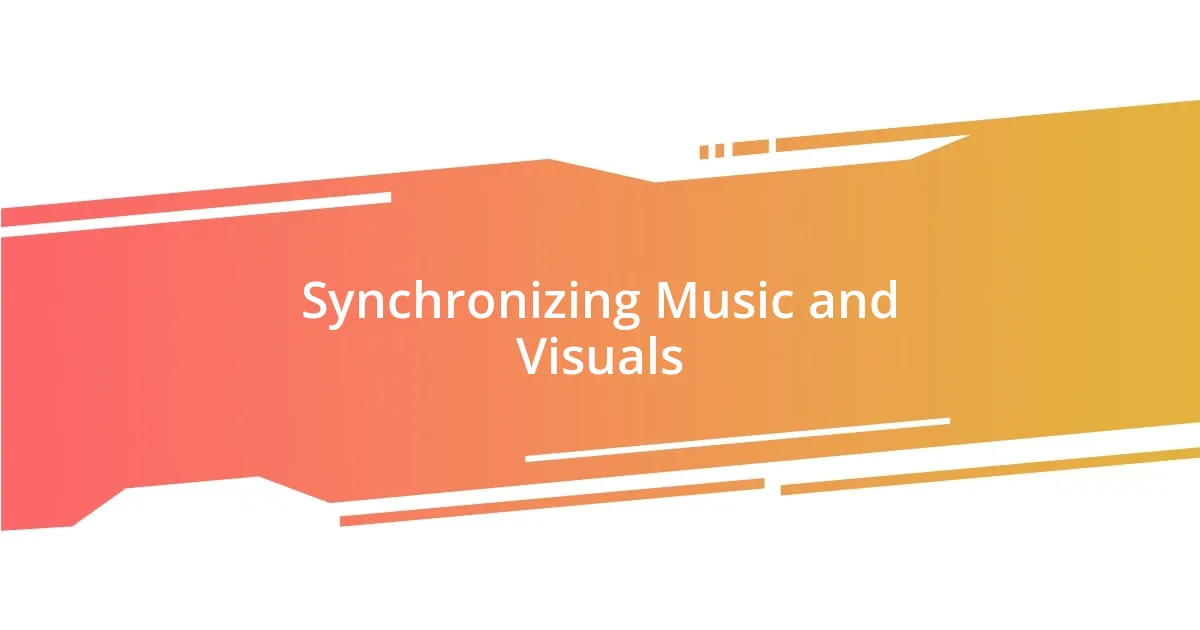
Synchronizing Music and Visuals
When it comes to synchronizing music and visuals, timing is everything. I’ve spent countless hours meticulously crafting my edits to ensure that each beat of the song aligns perfectly with the key moments of the video. This synchronization creates an emotional rush that enhances the viewing experience. Have you ever felt your heart race as a climactic moment in the visuals matched a soaring musical crescendo? It’s a thrill that makes the content resonate on a deeper level.
In my experience, contrasting rhythms can produce unexpected results. For example, during one project, I paired a slow, melancholic melody with quick-cut clips that depicted a bustling city life. The dissonance shocked viewers but also left a lingering sense of contemplation—illustrating the duality of lonely feelings amidst crowd dynamics. It’s amazing how deliberate mismatches can provoke thought and encourage a viewer to reflect upon their own experiences.
Finding that perfect moment to transition between visuals and sounds can be an art form in itself. I often experiment with various pacing styles, like having softer visuals draw out longer musical notes or using fast-paced footage with rapid beats to energize the scene. The crux of this synchronization is about creating a stirring experience; it should feel organic to the viewer’s senses, bringing forth emotions that the music and visuals together can uniquely evoke.
| Element | Impact on Viewer |
|---|---|
| Timing | Enhances emotional response and engagement |
| Rhythm Contrast | Encourages reflection and deeper thinking |
| Visual Transition Choices | Creates an organic and immersive experience |
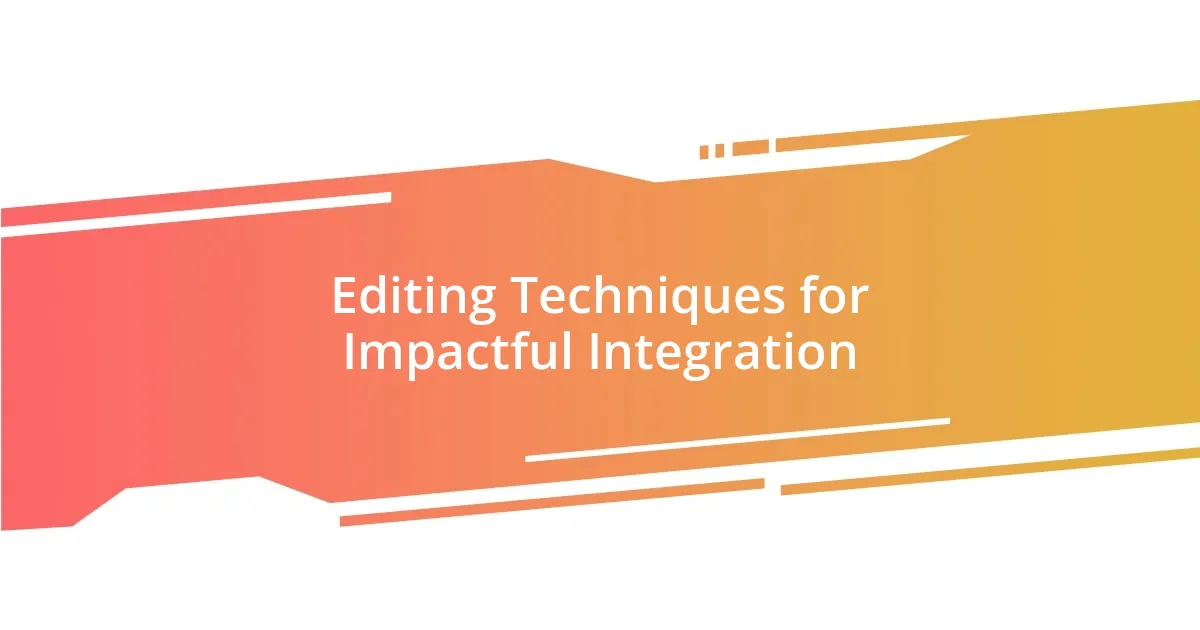
Editing Techniques for Impactful Integration
Editing plays a pivotal role in how music integrates with video, and I’ve learned some fascinating techniques that truly elevate the final product. One editing trick I often use is jump cuts, where I stitch together different moments of the performance. This technique not only maintains viewer interest but also creates a dynamic flow that can enhance the song’s energy. Remember that feeling when a sudden change in visuals just makes you sit up and take notice? That’s the magic I aim for in my edits.
Another powerful technique is the use of fade-ins and fade-outs to transition between various segments. By allowing images to slowly emerge or recede, you create a sense of anticipation or closure—much like the ebb and flow of a song itself. I recall a project where I faded into a scene of gentle waves lapping at the shore as the music softened. This seamless transition left viewers with a tranquil feeling, almost as if they were being cradled by the song’s soothing notes. How often do you find yourself lost in the moment when a video transitions just right?
Finally, layering visual elements can add richness to the experience. For instance, I often overlay text or graphics that resonate with the song’s lyrics, enhancing understanding and engagement. I experimented with this approach in a recent music video, where snippets of meaningful quotes appeared during key lyrical moments. It guided viewers to feel the message on a deeper level, reinforcing how my music speaks to their experiences. So, what editing techniques do you think could amplify your own storytelling? Exploring these avenues can transform a simple video into an unforgettable journey.
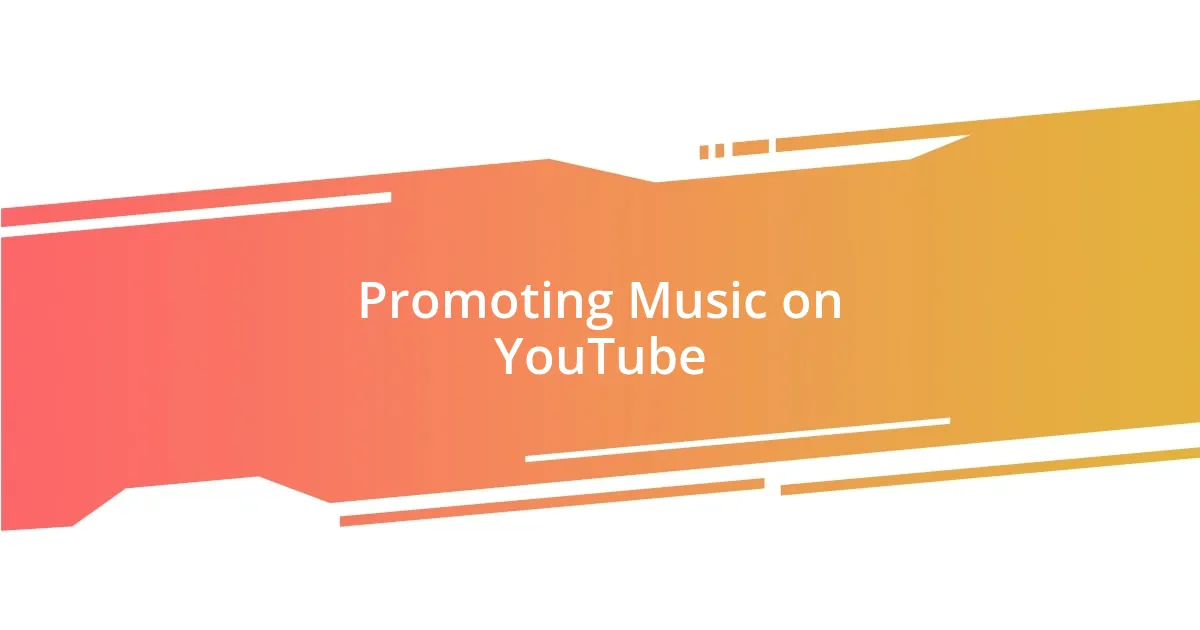
Promoting Music on YouTube
Promoting music on YouTube is an adventure that combines creativity with strategy, and I’ve found authenticity to be my best ally. I remember uploading one of my first music videos, feeling anxious yet excited. I shared it across social media and reached out to friends, asking them to spread the word. That initial push not only amplified my audience but also built a genuine connection with those who supported my journey. Have you ever tapped into your network like that? It’s amazing how word-of-mouth can ignite interest.
Engagement with the audience through comments and community posts has also been a game-changer for me. One time, I asked viewers for their favorite lyrics from my song, and the responses poured in—turning a simple question into a rich discussion. This interaction not only made my fans feel valued but also created a sense of belonging. Do you see your audience as a part of your creative process? Engaging with them can transform your promotional efforts into deeper relationships.
Lastly, leveraging YouTube analytics has been pivotal in promoting my music effectively. By keeping an eye on which videos perform best and where my viewers come from, I can tailor my promotional strategies accordingly. I recall seeing higher engagement on my behind-the-scenes content, prompting me to create more of it. Have you ever analyzed your metrics to improve your reach? Understanding the data is like having a map that guides your promotional journey, helping you navigate toward success.
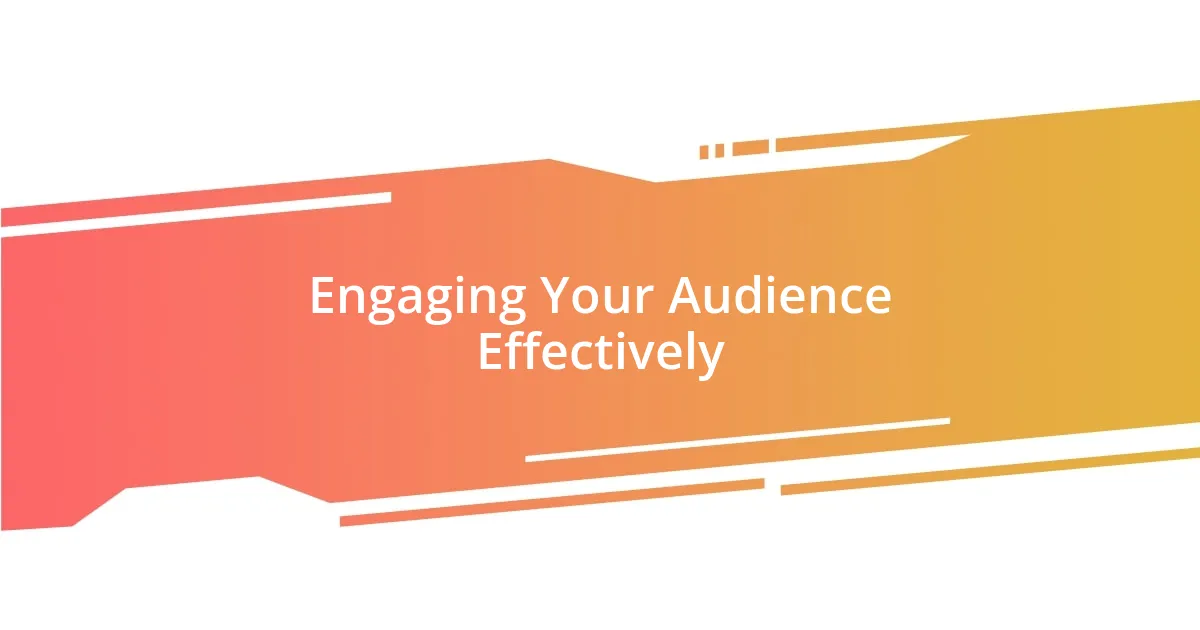
Engaging Your Audience Effectively
Engaging your audience effectively is all about creating a connection that resonates. I remember a time when I decided to incorporate interactive elements into my music videos, like polls asking viewers to vote on the next song I should cover. It was exhilarating to see them actively participate, and it deepened their investment in my work. When was the last time you turned your viewers into collaborators? That kind of engagement can truly elevate their level of interest.
Another approach I’ve found enormously valuable is storytelling through visuals. In one of my videos, I wove in personal stories that related to the song’s themes. Sharing snippets from my life—like a nostalgic trip with friends—turned the music into a backdrop for a shared experience. Have you ever thought about integrating your stories into your music? I believe that when audiences see a bit of themselves in your narrative, they’re more likely to stick around.
Creating an authentic space for dialogue is also crucial. After releasing a new track, I set aside time to respond to comments and share what inspired my lyrics. One viewer even told me how a particular line resonated with their struggles. That moment struck a chord with me; it reminded me that our art often speaks to shared human experiences. How do you foster conversations with your audience? By inviting them in, you turn mere viewers into a community that cherishes your music as much as you do.
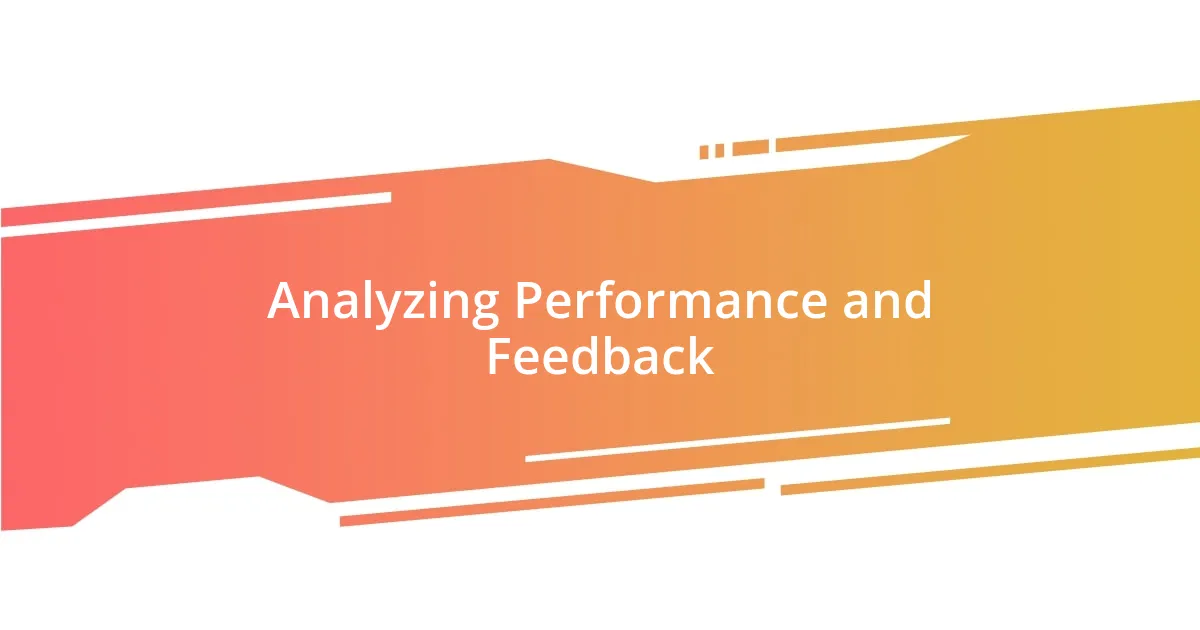
Analyzing Performance and Feedback
Analyzing performance and feedback is where the magic truly happens in my music journey. For instance, after posting a new video, I eagerly check analytics to see how it’s performing within the first few days. I remember releasing a music video that didn’t gain traction right away, and honestly, it stung a bit. But digging into viewer retention data revealed that people were dropping off at the same point repeatedly. It was a clear sign that my pacing needed to change—a valuable lesson learned!
Furthermore, engaging with comments offers rich, immediate insights from my audience. A couple of months back, a viewer mentioned how my last song helped them through a tough time. Their feedback reminded me of the powerful connections we form through music. I often wonder, have you ever had a moment where someone appreciated your work in a way that pushed you to keep going? Those conversations keep my passion alive and guide me toward what my audience craves.
Additionally, I make it a point to review the feedback on my community posts, too. When I once asked fans what they wanted next, the overwhelming response steered my creative direction in an exciting way. It’s fascinating how direct interaction can unveil preferences I might have overlooked. Have you thought about how your audience can provide invaluable direction to your creative process? By staying open to feedback, I’ve discovered not just what they want, but what truly resonates with my own artistic identity.










